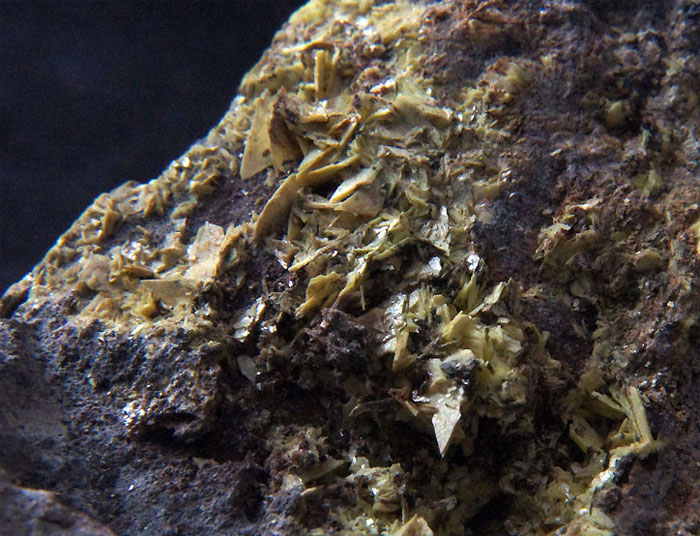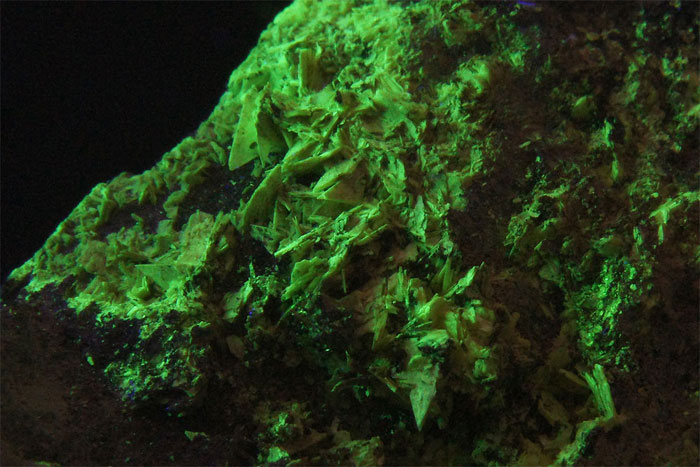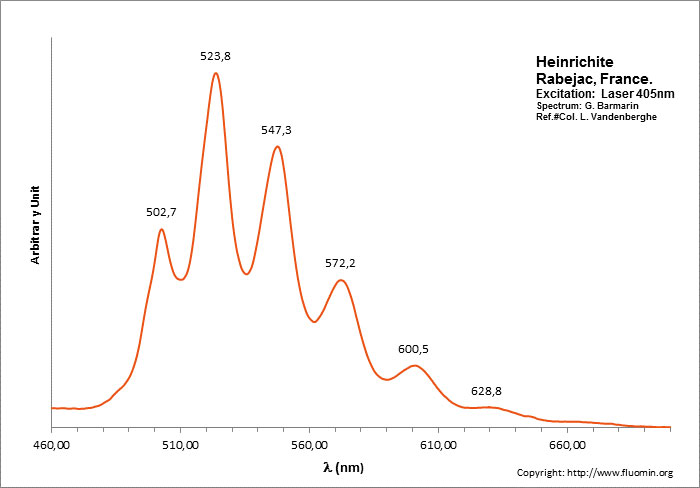Database of luminescent minerals
HEINRICHITE
Chemical formula: Ba(UO2)2(AsO4)2 10-12 H2O
Family: Phosphates, Arseniates, Vanadates
Status: IMA-GP
Crystal system : Monoclinic
Display mineral: NON
Luminescence:
Longwave UV (365nm) colors: |
Greenish Yellow , | ||
Intensity LW:Strong | Frequency LW:Always | ||
Shortwave UV (254nm) colors: |
Greenish Yellow , | ||
Intensity SW:Strong | Frequency SW:Always | ||
Daylight picture

HEINRICHITE ,
Mina Eureka termino de Castell-estaó,
municipio de La Torre de Cabdella,
Lérida province, Spain
Photo and Copyright: Joan Abella i Creus, Spain
Used with permission of the author
Shortwave (254nm) picture

HEINRICHITE , UVSW
Mina Eureka termino de Castell-estaó,
municipio de La Torre de Cabdella,
Lérida province, Spain
Photo and Copyright: Joan Abella i Creus, Spain
Used with permission of the author
Pictures Galery:



 ...
...Do you have a photo of this mineral you would like to see in the gallery? Contact us!
Phosphorescence (in the common sense of the term) observable with the naked eye:
No phosphorescence visible to the naked eye under any type of UV
Comments:
Unstable at room temperature and dehydrates fairly rapidly to metaheinrichite
Activator(s) and spectrum:
Activator(s): (UO2)2+ (ion Uranyle) intrinsèque ,
Peaks in the spectrum (nm):
(UO2)2+ : 495.0, 505.8, 528.4, 551.4, 577.7, 604.6nm

HEINRICHITE, Excitation: laser 405nm. Col. L. Vandenberghe; Spectre: G. Barmarin
Best localities for fluorescence (*):
- Schmiedestollen dump, Wittichen, Schenkenzell, Black Forest, Baden-Württemberg, Germany;
- Krunkelbach Valley Uranium deposit, Menzenschwand, Black Forest, Baden-Württemberg, Germany;
- White King Mine, Lakeview, Lake Co., Oregon, USA;
- Fuemrol No. 2 mine (Fuemrole mine), Temple Mountain, San Rafael District (San Rafael Swell), Emery Co., Utah, USA;
- ina Eureka termino de Castell-estaó, municipio de La Torre de Cabdella, Lérida province, Spain;
(*)The data are not exhaustive and are limited to a few remarkable localities for fluorescence
Bibliographic reference for luminescence:
- The Henkel Glossary of Fluorescent Minerals, Dr. Gerhard Henkel, Published by the FMS, 1989 ,
- Fluorescence: Gems and Minerals Under Ultraviolet Light, Manuel Robbins, 1994, Geoscience Press, ISBN 0-945005-13-X ,
- Uranium minerals Website: http://www.uraniumminerals.com ,
- Spectroscopic properties of uranium(VI) minerals studied by TRLFS, G. Geipel and Al. Radiochim Acta 88 (2000) ,
- Introduction to radioactive minerals, Robert Lauf, Schiffer Publishing, 2008, ISBN 978-0-7643-2912-8 ,
Reference for luminescence on the Internet:
- Joan Abella i Creus;
- http://www.handbookofmineralogy.com/pdfs/heinrichite.pdf
Images:
- Wittichen, Germany http://www.mindat.org/photo-651363.html
Mineralogical reference on the Internet:
 http://www.mindat.org/show.php?name=Heinrichite
http://www.mindat.org/show.php?name=Heinrichite
 http://webmineral.com/data/Heinrichite.shtml
http://webmineral.com/data/Heinrichite.shtml
Internet Search:
 Image search on 'Google Images'
Image search on 'Google Images'
 Search for documents in all languages on Google
Search for documents in all languages on Google
A request providing no result means only that no such reference exists in the database, but it does not mean that what you are looking for does not exist, just not to our knowledge. If you think you have found an error or omission, please let us know via the contact page being sure to cite the source of information.

